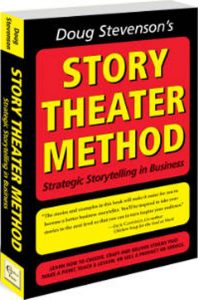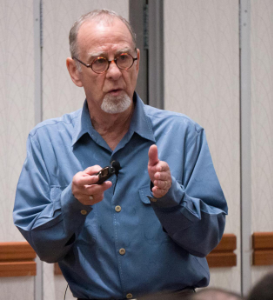June 15, 2019
If Your Story Doesn’t Fit – Don’t Use it
There are all kinds of stories: long and short, dramatic and comedic, business and personal. Some stories are big dramatic stories with strong emotions and powerful lessons. Others are smaller stories that simply illustrate a lesson learned from a moment in time.
While all stories are not equal, all stories can be appropriate, relevant, and powerful if they fit the situation and address a business issue or topic. A story is an essential communication tool, regardless of whether it is big or small, long or short, or dramatic or comedic.
If you want to be a compelling and engaging communicator, you must choose the right story that makes the right point for the right situation. If the story doesn’t fit, don’t use it.
It’s All About the Fit
From 1972 to 1985, I lived the life of an aspiring actor and movie star wanna-be in Hollywood. I took acting classes, acted in plays and auditioned for movie and TV roles. Because I wasn’t making a living as an actor, I had to do something to pay the bills. I needed a job. One day my friend Michael called me and said the contractor he was working for was looking to hire another guy for his carpentry crew.
I learned a lot about carpentry while working for that contractor. When I began, I didn’t even own a hammer. So every week I took a portion of my paycheck and bought more tools. I eventually started my own carpentry and remodeling business and continued to purchase more tools. Every job seemed to require a specific tool that I didn’t have. After ten years in the carpentry and remodeling business, I had carpentry, plumbing, and electrical tools for every kind of job and need.
I never did become a movie star, but I did become a very accomplished carpenter! What I learned from that experience was that it’s not about how many tools you have, it’s all about having the right tool for the job. And it’s not about how many good stories you have, it’s all about having the right story for the point you want to make. It’s all about the fit.
Start with the Point in Mind
Your story can be long or short, as long as it does the job. Just as there are many kinds of screwdrivers, there are many kinds of stories.
To find the right story, start with the point in mind. What do you need a story to do?
- Inspire someone to believe in themselves?
- Get someone to work within established guidelines?
- Teach a better way to do something (behavior)?
- Communicate why a change is being made?
- Illustrate the danger of making bad choices?
- Persuade someone to buy your product or service?
- Help people to lighten up and laugh a little?
- Make a complex idea simple?
- Introduce a new perspective?
Develop Your Story Using the Nine Steps
Great storytellers don’t just hope to get lucky. They spend significant time choosing the right story and crafting it for maximum impact. Many other speakers spend far more time building boring PowerPoint slide decks than developing their stories. You don’t have to reinvent the wheel when it comes to storytelling. Classical story structure has been around for thousands of years, and it works!
Here is my Story Theater version of classical story structure. I call this The Nine Steps of Story Structure. Follow these steps and your story will have a logical sequence, as well as solid dramatic tension. It will also contain a clear and concise, actionable lesson.
- Set the Scene – when and where?
- Introduce the Characters – who else was there?
- Begin the Journey – what was the task or goal?
- Encounter the Obstacle – what goes wrong or impedes progress?
- Overcome the Obstacle – how was the problem dealt with?
- Resolve the Story – how did things work out in the end?
- Make the Point – what is the one thing above all else that you learned?
- Ask the Question – transfer the lesson to the listener, “how about you?”
- Restate the Point – restate the lesson of the story as a call to action
Each Story Makes One Point Each Time You Tell It
Just about every story you come up with has the potential to make a number of points or teach a variety of lessons. Pick one and only one. Keep it simple. The more points you add at the end of your story, the less powerful each one becomes.
Make the point of your story a call to action. I call it a “Phrase That Pays.” Start with a verb. Here are some examples of verb oriented, call-to-action phrases:
- Make your move
- Take it one step at a time
- Run your own race
- Start yesterday
- Ask for what you want
- Stand in your power
- Get to the starting line
- Look for the Limo
Whether you’re telling a story to one person, ten or ten thousand; on the phone or in-person; in the office or on the main stage, it’s all about the fit. Make your story relevant.
For many years I had a few brilliantly-crafted stories that I told all the time. I told them because they were great stories and audiences liked them. After a while, I started to get so dependent on those stories that I was sticking them into keynotes where they didn’t belong. I recall one time, I told one of my stock stories in a leadership keynote, and immediately realized that it was the wrong story for the audience and their current situation. It just wasn’t the right fit.
You may have some wonderful stories that people love. Before you decide to use them in your next program, ask yourself if they are the perfect fit for that occasion. If you realize that the audience needs something different than what is already in your story toolkit, develop another story just for them.
Remember, it’s all about the fit.
Here are some links to articles that will assist you in finding and crafting the right story that is relevant to the points and lessons you want to share with your audience.
How to Find Your Stories:
https://storytelling-in-business.com/find-your-stories-five-quick-tricks/
The Nine Steps of Story Structure:
https://storytelling-in-business.com/the-nine-step-of-story-structure-updated-for-2011/
The Phrase That Pays
https://storytelling-in-business.com/page/2/?s=phrase+That+pays&submit=Search
*********************************************************************************************************************************************
 Doug Stevenson, CSP, works with individuals and organizations to help them identify and tell inspiring stories that make a point, teach a lesson or sell a product or service. He is the president of Story Theater International, a Tucson, Arizona based consultancy. He is the creator of The Story Theater Method and the author of the book, Doug Stevenson’s Story Theater Method and the Next Level Video eLearning Series.
Doug Stevenson, CSP, works with individuals and organizations to help them identify and tell inspiring stories that make a point, teach a lesson or sell a product or service. He is the president of Story Theater International, a Tucson, Arizona based consultancy. He is the creator of The Story Theater Method and the author of the book, Doug Stevenson’s Story Theater Method and the Next Level Video eLearning Series.
His has delivered keynote speeches, workshops and training courses on storytelling and story selling for clients in 18 countries from Singapore to San Diego, Copenhagen to Chicago and Bogota to Boston. His clients include Aetna, Abbott Labs, Amgen, Caterpillar, Coca Cola, Con Agra Foods, Deloitte, Google, Genentech, Hewlett Packard, Lockheed Martin, Microsoft, Novartis, Oracle, Pfizer, US Bank, Wells Fargo, Volkswagen, Verizon, The Nickelodeon Channel, The Department of Defense, The National Education Association and many more.
To inquire about Doug’s availability for your next meeting, conference or convention, email: [email protected]
Doug can be reached at 1-719-310-8586. Learn more about how Doug can help you tell your story, purchase the book, eBook or Story Theater audio six pack, and sign-up for the free Story Theater newsletter at: www.storytelling-in-business.com.







